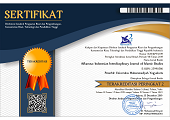The Export of Islamic Revolution in Iran and Its Threat for the US, the Soviet Union, and Arab Countries
Abstract
The relationships between Islam and the West have become an important issue in the international world until today. Islam and Muslim countries are part of the factors which influenced the political dynamics in the world. In this regard, the Islamic Revolution in Iran in 1979 is one of the major issues that contributed to the shaping the relationship between Islam and the West, even until to date. This is because this revolution has inspired the emergence Islamic movements around the world and triggered anti American sentiment among Muslims. This revolution also shaped the perception about the threat from Islamic fundamentalism in the West. This article will analyze the back- ground and the context of the Islamic Revolution in Iran and its impacts on the United States, the Soviet Union, and the Arab states. It will argue that the Islamic Revolution become the major threat for all the countries because Iran has placed its revolution as the asset that would be exported to other countries. This revolu- tion has challenged Western interests in the Middle East particularly on oil and natural gas supplies. The Islamic revolu- tion also threatened the authoritarian regimes in the Middle East which often oppressed their people in the name of Islamic legitimacy.
Keywords
Full Text:
PDFReferences
Amineh. M.P. and S.N. Eisenstandt. 2007. “The Iranian Revolution: The Multiple Context of the Iranian Revolution” Perspective on Global Development and Technology (PGDT) 6 (2007), 129-157, Leiden: Koninklijke Brill NV
Arjomand, S.A. 1986. “Iran’s Islamic Revolution in Compara- tive Perspective”, World Politics. Vol. 38. No. 3. April
Beeman, W.O. 1983. “Images of the Great Satan: Represen- tations of the United States in the Iranian Revolution”, in N.R. Keddie (ed.), Religion and Politics in Iran: Shi’ism from Quietism to Revolution. New Haven and London: Yale University Press
Bill, J.A., 1982. “The Arab World and the Challenge of Iran”, Journal of Arab Affairs, Boulder: Oct 31. Vol. 2., Iss. 1, pp 29–46.
Cleveland, W.L. and Bunton, M., 2009. A History of the Middle East. Boulder: Westview Press.
Cottam, R.W. 1988. Iran and the United States, A Cold War Case Study, Pittsburgh: the University of Pittsburgh Press
Emadi, H., 1995. “Exporting Iran’s Revolution: The Radicalization of the Shiite Movement in Afghanistan”. Middle Eastern Studies. Vol. 31. No. 1. January
Hunter, S.T. 1990. Iran and The World: Continuity in a Revolutionary Decade. Bloomington and Indianapolis: Indiana University Press
Jabbari, A. and Olson, R. (eds.). 1981. Iran: Essays on a Revolution in the Making. Lexington: Mazda Publishers
Khosrokhavar, F. 2004. “The Islamic Revolution in Iran: Retrospect after a Quarter of A Century”, Thesis Eleven, No. 76. February London: SAGE Publications
Rakel, E.P. 2007. “Iranian Foreign Policy since the Iranian Islamic Revolution: 1979-2006”, Perspective on Global Development and Technology (PGDT). Leiden: Koninklijke Brill NV
Saikal, A. 2003. Islam and the West, Conflict or Cooperation, New York: Palgrave Macmillan
Scokpol, T. 1982. “Rentier State and Shi’a Islam in the Iranian Revolution”, Theory and Society. Vol. 11. No. 3. May
Sheikhneshin, A.G. 2009. “Iran and the US: Current Situation and Future Prospects”, Journal of International and Area Studies, Vol. 16. No. 1
Stempel, J.D. 1981. Inside the Iranian Revolution. Bloomington: Indiana University Press
Yodfat, A.Y. 1984. The Soviet Union and Revolutionary Iran. New York: St Martin’s Press.
DOI: https://doi.org/10.18196/aiijis.2012.0001.1-13
Refbacks
- There are currently no refbacks.
Copyright (c) 2015 Afkaruna: Indonesian Interdisciplinary Journal of Islamic Studies

This work is licensed under a Creative Commons Attribution-ShareAlike 4.0 International License.
Afkaruna: Indonesian Interdiciplinary Journal of Islamic Studies indexed by:












1.png)


